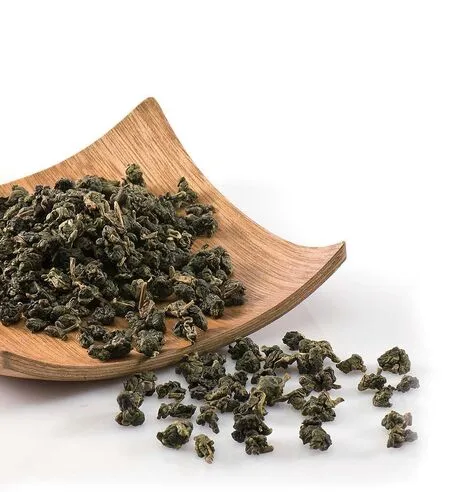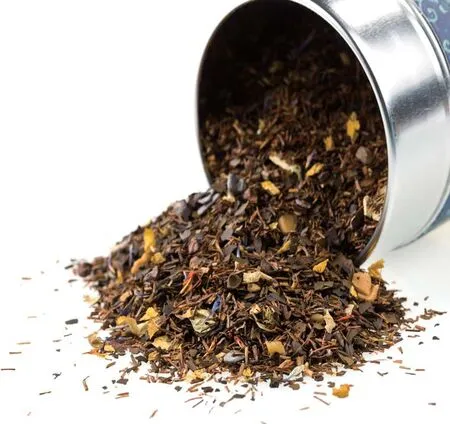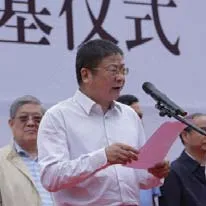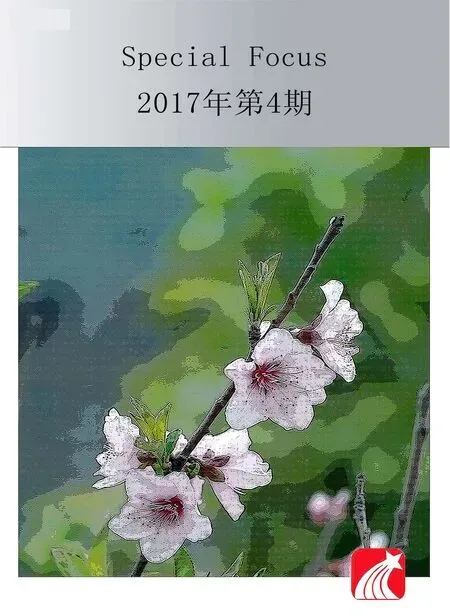第五章:一个世界,一杯黄鹤楼茶
2017-07-03
第五章:一个世界,一杯黄鹤楼茶


1
在汉口硚口区崇仁路与京汉大道的交会处,“汉口茶市”四个字十分醒目,这里是中南地区最大的茶叶市场。
“汉口茶市”四个字下面写着1858。这个数字,总能让人的思绪追溯到汉口茶市最为繁荣的时候——汉口江边坐落着大大小小的码头,搬运工们的汗水落在青石板上,将一担又一担的茶叶装上船。在离江边不远的汉正街,人声鼎沸,商贩络绎不绝,小小的街道旁都是各种卖茶商铺……
“Hankou Tea Market” etched in bold calligraphy is located at the intersection of Chongren Road and Jinghan Avenue, a downtown area in Qiaokou District of Hankou. It is the largest tea market in central and southern China.
Underneath the Chinese characters of the “Hankou Tea Market” is engraved “1858,” a year that harkens to mind the glory days of the Hankou Tea Market. There were many ports in Hankou, small ones and large ones alike, lining the shores of the river. Drops of salty sweat fell upon the stone road from the porters’ faces as they loaded crate after crate of tea onto ships by bamboo poles hoisted upon their sinewy shoulders. Along the famous Hanzheng Street, where tea-shops lined both sides of this narrow cobblestone avenue not far away from the Hankou beach of the Yangtze River, a cacophony of human voices mixed with the metallic clinking and clanging of cargo being brought on deck, as endless streams of street vendors flew in and out of the scene like the river waters it nestled up against.



如今,在距有名的汉正街仅一百米距离汉口茶市,同样是武汉市的一块“黄金宝地”,古今景象却大不相同——白天,这里是繁忙的交易场所,批发出的茶叶散向荆楚大地和江西、安微、湖南、河南等地;夜晚却成了休闲的泡茶场所,每家店的门口都支起小桌子,悠闲的市民从四面八方来到这里聊天品茗,汇集成了武汉市的一道风景。
这里聚集了近五百家茶叶商铺。夜幕下,家家霓虹闪烁:安溪铁观音、西湖龙井、洞庭碧螺春、君山银针、信阳毛尖、台湾冻顶乌龙、人参乌龙等等,几乎各国各地所有的名茶在这里都能买到。
The Hankou Tea Market, situated only about 100 meters away from Hanzheng Street, is a treasured center of fortune in contemporary Wuhan, but the scene was vastly different in the old times. By day, it was a busy trading hub that wholesaled tea to Hubei, Jiangxi, Anhui, Hunan, Henan and other areas. By night, it transformed into a mild and leisurely tea haven, with every store outfitted with small tea displays set out on tables, where people from all over would sit together basking in the glow of the languid atmosphere; sipping and confabulating. This constituteedd a typical street scene of Wuhan at tthhee time.
Nearly 500 tea shops converged here. Under the shroud of night’s darkness, every shop brightened the scene with a neon glow. Every kind of tea imaginable from all over could be purchased here, including Tieguanyin (also Kuanyin) Tea from An’xi, Dragonwell Tea from West Lake, Green Snail Spring Tea from Dongting, Silver Needle Tea from Junshan, Maojian Tea from Xinyang, Frozen Peak Oolong from Taiwan, Ginseng Oolong, and many more.



而几乎所有这里的茶商,只要提起“张岳峰”这个名字,无不竖起拇指感叹:“他简直就是一个‘茶痴’啊!”
武汉有三家比较大的茶市:武昌复兴路的“陆羽茶庄”,汉口崇仁路的“汉口茶市”以及香港路茶市。其中香港路茶市是武汉市第一家专业的茶叶市场;崇仁路的“汉口茶市”则拥有“中南第一茶市”的称号,年交易额占湖北省总交易额的一半;而“陆羽茶都”则被誉为华中地区茶叶商品流通贸易的“摩尔”,市场年交易额达23亿多元。
这三家茶市都归属于湖北黄鹤楼茶叶公司。张岳峰是武汉黄鹤楼茶叶公司的董事长兼总经理,也是这三家茶市的创办人。
早在上世纪90年代初期,张岳峰担任武汉市茶叶公司总经理。那时正值计划经济向市场经济转变的时候,很多茶农都是刚从大山里出来的“赤脚汉”,根本不懂怎么做生意,湖北的茶叶市场一度陷入混乱和低迷。
看着每年上好的新茶堆在茶农手中变成涩口的陈茶,张岳峰心疼又心焦,他决心帮茶农们改变这种处境。
在一次乘飞机出差途中,张岳峰恰巧与麦德龙一全球负责人邻座。双方一见如故,很快就热络地交谈起来。在那个时代的中国,“超市”对于国内来说还十分陌生,麦德龙搭平台、做卖场的经营思路顿时让张岳峰茅塞顿开:“与其帮一个个茶农寻销路、卖茶叶,不如搭建一个专业的茶叶市场作为平台,吸引客商前来。”
回来后,张岳峰克服重重困难办完各种手续,终于建成香港路茶叶市场,并在三个月之内完成全部招商。1997年,这个湖北省首家大型专业茶叶批发市场开业。一时间,香港路茶商云集,熙熙攘攘。

张岳峰,武汉黄鹤楼茶叶有限公司创始人Zhang Yuefeng, founder of Wuhan Yellow Crane Tower Tea Co., Ltd.
If the name Zhang Yuefeng was even mentioned in the area, almost every tea merchant would stop and give a big thumbs up, saying, “That man is a huge tea buff.”
There are three relatively large-scale tea markets in Wuhan today: “Luyu Tea City”on Fuxing Road, Wuchang, Hankou Tea Market on Chongren Road, and Hong Kong Road Tea Market. Hong Kong Road Tea Market was the first market specializing in tea in Wuhan, while Hankou Tea Market on Chongren Road earned the reputation of “The Number One Tea Market in South China,” with an annual trade volume that accounts for half of the total turnover in Hubei Province. Yet, Luyu Tea City enjoys the lofty title of the “wunderkind” of the tea trade in central China, as its annual volume was worth more than RMB 2.3 billion.
Every one of these three tea vendors belongs to the Hubei Yellow Crane Tower Tea Co., Ltd., whose Chairman and CEO is none other than Mr. Zhang Yuefeng, the founder.
At the dawn of the 1990s, Zhang Yuefeng was the general manager of the Wuhan Tea Company. During the time of China’s transition from planned economy to market economy, many tea farmers, who were “bare-foot with green hands” fresh out of the mountains, came to the Hubei tea market without a lick of business sense and trying to rely on their horse sense, turned it into a disaster.
Seeing the fresh tender tea leaves turned into piles of stale mulch in the storehouse due to bad sales, he felt distressed and anxious and he endeavored to change the situation and help the tea farmers.
While jet-setting on a business trip, Zhang Yuefeng just happened to rub elbows with the marketing manager of the global supermarket chain, Metro. The two were like a reunited set of twins who had been separated at birth—they felt an immediate kinship and sat chatting for hours. In the course of their conversation, an idea suddenly dawned on him to build a professional tea market that could attract customers and dealers by adopting the business philosophy of Metro and bringing the“supermarket” concept to his own business platform.

2005年,武汉市茶叶公司更名为武汉黄鹤楼茶叶有限公司,张岳峰担任董事长兼总经理。
“黄鹤楼”是武汉的一块金字招牌,武汉以“黄鹤楼”冠名的烟、酒、茶相继成为武汉的拳头产品。黄鹤楼烟、黄鹤楼酒由来已久,而黄鹤楼茶这一品牌却是新秀。为了不辜负“黄鹤楼”这个金字招牌,张岳峰大刀阔斧进行改革。
首先,武汉黄鹤楼茶叶公司通过设立规模门槛和技术标准门槛,整合全省乃至全国的茶叶资源,让自有茶叶基地规模在300亩以上,有环保化、机械化加工场所的茶企可以申请使用黄鹤楼茶叶商标,扩大汉产茶叶市场规模。
此外,在政府支持下,武汉黄鹤楼茶叶公司还投资建设50万平方米的中国(国际)茶交易中心;在武汉市江夏区建成中俄万里茶道新泰砖茶厂;在神农架建设集种植、科研、加工、茶博院、休闲旅游等多功能于一体的茶祖印象园……

▲时任市长唐良智亲临黄鹤楼1861东方茶港旗舰店调研工作Former Wuhan City Mayor Tang Liangzhi visiting 1861 Oriental Tea Port Flagship Store of Wuhan Yellow Crane Tower Tea Co., Ltd.

▲张岳峰在参茶庄柜台Intercultural exchange on tea between Zhang Yuefeng and foreign friends
In 2005, the Wuhan Tea Company changed its name to the Wuhan Yellow Crane Tower Tea Co., Ltd, with Zhang Yufeng serving as Chairman and CEO.
“Yellow Crane Tower” is an honored brand in Wuhan. Cigarettes, alcohol and tea, all carrying the brand-name Yellow Crane Tower are important and famous products in Wuhan. Yellow Crane Tower cigarettes and alcohol have a long history, but Yellow Crane Tower Tea is brand new. In order to live up to the Yellow Crane Tower reputation, Zhang Yuefeng instituted drastic reforms.
First, the Wuhan Yellow Crane Tower Tea Co., Ltd integrated its tea production base by upgrading the scale of operation as well as technology to make it a province-wide and even country-wide base of operations. The total area of his tea production base is larger than 49 acres. It allows environmentally friendly and fully mechanized tea processing plants to apply for usage of the Yellow Crane Tower brand, by which it has scaled up Wuhan tea in the tea market.
In addition, the Wuhan Yellow Crane Tower Tea Co., Ltd. has invested in many tea-related projects, including the construction of a 500,000 square meter International Tea Trading Center, establishing the Xintai “Sino-Russo Tea Road” Brick Tea Factory in Jiangxia District of Wuhan, and building a multifunctional tea god impression park with facilities for tea planting, research, processing, exhibition and entertainment.
2
汉口自古因茶而兴。说起汉口乃至中国的茶历史,张岳峰就像是一个活字典,可以信手拈来。而他对茶的喜爱,几乎到了痴迷的程度。
他的办公室里有一个专门用于茶叶烘焙的烘笼机,如果没有人打扰,他可以一个人在办公室一待就是一整天,潜心研究各种制茶工艺。
“别人出差,随身的箱子里都是换洗衣服、生活用品,但张总的箱子里却是茶壶、茶叶、茶书。”在公司,凡是跟张岳峰出过差的人都知道,他可以一天不吃饭,但绝不可能一天没有茶。
张岳峰爱茶成痴。
在位于汉口江滩的黄鹤楼“汉口茶港”里,400多平方米的营业区,除了黄鹤楼茶等各类知名茶品种和特色茶具外,还有一批反映近代汉口茶叶贸易和茶馆文化的珍贵历史照片和文献,俨然一座近代汉口茶文化历史博物馆。工作人员告诉记者,这些都是张岳峰多年悉心收藏的成果。
门外,一座石碑面对烟波浩瀚的万里长江静静地伫立着。碑上“中俄万里茶道起点——东方茶港”几个大字,记载着当时万里茶路的辉煌。而这一石碑得以确立,离不开张岳峰的心血。
2013年3月23日,国家主席习近平访问俄罗斯,在莫斯科国际关系学院作了《顺应时代前进潮流促进世界和平发展》的精彩演讲,讲演中他特别提到,17世纪的“万里茶道”是连通中俄两国的“世纪动脉”。

敏感的张岳峰立刻意识到,这对扩大湖北茶品牌影响力、弘扬湖北茶文化,是个难得的契机,而作为“万里茶道”起点的汉口,理应有所担当。于是,张岳峰四处奔走,四处向人讲述汉口老茶仓、中俄万里茶道的故事,以期确立汉口成为万里茶道起点。终于,历经近一年的努力,这一项目终于得到批复。
2013年12月29日,这块近两米高的纪念碑终于落成。
它掩映在绿树之间、万花丛中,毗邻武汉防汛纪念碑和江滩老武汉风情雕塑群,前有烟波浩瀚的万里长江,后为武汉百年老建筑的沿江大道,在飘渺的蓝天白云衬托下,显得十分威武。
立碑那天,整个江滩热闹非凡,而张岳峰的心里更是异常激动。是啊,大江东去,一泻千里,万古流淌,汉口码头,百年沧桑,风云激荡。这块石碑不仅是百年前汉口茶仓辉煌的几年,更将成为汉口续写辉煌的见证……
For the longest time, tea has allowed Hankou to prosper and Zhang Yuefeng is a living encyclopedia on the history of Hankou and Chinese tea, he is truly obsessed with it.
There is a machine for roasting tea at his office, and he can stay there immersed in his study of teaprocessing technology for a whole day if nobody interrupts him.
“When other people travel, they take a carry-on suitcase with a change of clothes, household items and daily necessities, but Zhang’s suitcase is always filled with teapots, teas, and tea-related books,” his colleagues all know he can go without food for a whole day, but can never go without tea for a day.
Zhang Yuefeng really loves tea. Strike that … he is crazy about tea.
The Yellow Crane Tower “Hankou Tea Port”is located on the banks of the Hankou River, and boasts a 400 square meter business area. Besides carrying every kind of famous tea imaginable and special tea sets bearing the Yellow Crane Tower brand, there are also valuable historical photos and documents recording modern Hankou’s tea trade and tea houses. The place is like a museum of Hankou tea culture and history. The staff there reported that those products have been meticulously collected by the hands of Zhang Yuefeng for years.
Outside, a stone tablet sits facing the vast Yangtze River blanketed by downy-white mist. It is a monument to the local tea industry, and etched into it are the following words, “Starting point of the Sino-Russo Tea Road—the Oriental Tea Port.” The tablet records the glory of the Tea Road. This tablet would never have been established without the efforts of Mr. Zhang Yuefeng.
On March 23, 2013, President Xi Jinping visited Russia and made an inspiring speech on “The Trends of the Times and Promoting Peace and Development in the World” at the Moscow State Institute of International Relations, the Tea Road of the 17th century was called “the most important link of the century.”
Zhang Yuefeng immediately realized the golden opportunity to expand the influence of the Hubei tea brand and promote the tea culture of Hubei. As the starting point of the Tea Road, it is only fitting that Hankou should play an important role. Zhang Yuefeng has related the stories of Hankou’s reputation as the great tea storehouse and stories of the Tea Road to people from all around to establish the position of Hankou as the starting point of the Tea Road. This project was approved after almost a year of effort.
On December 29, 2013, the nearly two-meter high monument was eventually set up, where it is nestled in between the groves, adjacent to Wuhan Flood Memorial and the old Wuhan sculpture groups at the river beach. In front of it is the vastness of the Yangtze River, and behind it is the Riverside Avenue lined up with century-old buildings. This monument looks enormous and mighty against the backdrop of misty blue sky and white clouds.
With the monument established that day, the entire river beach bustled with extraordinary energy. And Zhang Yuefeng’s heart undulated with joy. Yes, the great river flows east, the water rushes on, eternally flowing. The ports of Hankou, a hundred years and still counting, a thousand vicissitudes and still standing. This piece of stone is not only a testament to those few years of booming brilliance of the Hankou tea trade that happened a hundred years ago when Hankou’s golden years as the great tea storehouse were in full swing, but it will also bear witness to the many years of brilliance that are yet to come.
Chapter 5: The World of Yellow Crane Tower Tea
efeng completed the documents and
all the necessary permits upon his return, and ultimately established the Hong Kong Road Tea Market, by securing his needed investment within three short months. In 1997, the first largescale professional tea wholesale market opened in Hubei; in the blink of an eye, the Hong Kong Road Tea location was hustling and bustling.
